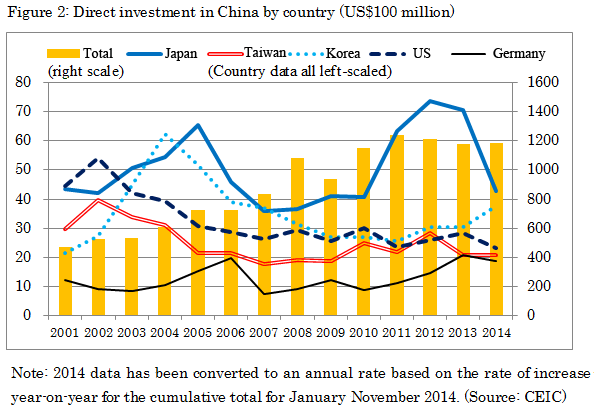Media International Exchange 2015.02.04
Chinese Market Structural Change and Growing Opportunities for Japanese Firms
The previous article described how rapid income growth in China gave rise to a massive domestic market, with internationally competitive Japanese firms achieving success as a result of the jump in high-value-added product sales. Here we examine the impact of this Chinese domestic market on Japanese companies and the Japanese economy.
Japanese companies familiar with China know from experience that when the per capita GDP of China's major cities reaches US$10,000, local demand for the various products and services offered by Japanese companies will suddenly expand. This phenomenon can be seen in a wide range of product and service areas, with typical examples including disposable diapers, milk powder, baby bottles, air conditioners, air purifiers, televisions, stationery, clothes, convenience stores, and Japanese restaurants.
Because of the even income distribution across Japanese society, most products and services offered by Japanese companies target customers falling within Japan's average income bracket, a relatively narrow income range compared to other countries' companies. Previously, therefore, while Chinese consumers recognized the quality of Japanese products and services, they were simply too expensive for Chinese wallets. However, once Chinese incomes start to match those in Japan, Chinese consumers start to perceive value in high-quality products, and demand for Japanese firms' products and services suddenly booms. The tipping point is that US$10,000.
While it fluctuates significantly according to the yen-dollar exchange rate, if we take US$10,000 as roughly one million yen, this means a city's average annual income for a family of two adults and one child reaching around three million yen. Because of the huge gap between rich and poor in China, areas where the average annual income has reached three million yen have a large percentage of households with annual incomes over five million yen. At that level of earning, Japanese products and services obviously become well within reach.
Moreover, China's nominal growth rate sustained a rate of income increase that was unbelievably high by the standards of the developed world-between 17 and 22 percent-for the eight years between 2004 and 2011 (excluding 2005 and 2009, when growth rates were 15.7 percent and 8.7 percent respectively). As a result, despite the massive income gap between the coastal cities that have run the leading edge of economic development and the less-developed cities of inland China, since per capita GDP reached US$10,000 in the front-running cities, it has not been unusual for less-developed cities to achieve the same level a few years later.
Figure 1 lists cities achieving a per capita GDP of US$10,000 by the year in which they reached that mark. Since Suzhou, Wuxi and Shenzhen became the first cities to get there in 2007, the strength of China's nominal growth rate has seen more major cities join them every year. In other words, the potential customer bracket for Japanese firms is continuing to expand around China at what is by Japanese lights an unimaginably rapid pace.

Despite this enormous change, the volatility enveloping the Chinese economy for the three years between 2007 and 2009-overheating-induced inflation; a sharp stall in response to a rigorous tightening of macroeconomic policy; the downturn following the Lehman shock; and rapid recovery caused by powerful economic stimulus-meant that Japanese companies too did not notice the above structural changes proceeding in the Chinese market.
When the Chinese economy calmed down again in 2010, many Japanese companies realized that demand for Japanese products and services was booming in the main coastal cities. At that time, European and American companies were still struggling to recover from the imbroglio resulting from the collapse of their respective economic bubbles after the Lehman shock, but because Japanese firms had distanced themselves to some extent from these bubble economies, they emerged almost unscathed from the collapse and recovered relatively quickly.
Figure 2 shows Japanese companies alone among the world's major economies driving up their foreign direct investment in China as of 2011. As these statistics have a time lag of close to a year, they in fact reveal that Japanese companies became bullish on their China investment from 2010 onward.
As of September 2012, the Senkaku Islands dispute brought Japan-China relations to a new low, making Japanese companies suddenly extremely wary of the China risk, and direct investment in China consequently plummeted in 2013.

Since the beginning of 2014, however, the Chinese government has made clear its intention of separating politics and business in relations with Japan and actively encouraged more investment from Japanese companies, with companies gradually relaxing as a result. In addition, the urban population belonging to the "US$10,000 club"-in other words, the number of potential customers for Japanese firms-is expected to reach 700 to 800 million by 2020, and corporate majors from around the world are competing to develop markets for their products. As Japanese companies are hardly going to slight such an important market, a recovery in direct investment would seem only a matter of time.
Over the last two years, even as most Japanese companies have been cautious in their China investment, the less-developed cities inland have become much better investment prospects due to the construction of expressways, high-speed rail and other infrastructure, with industrial clusters expanding rapidly. As a result, a growing number of inland cities too are joining the US$10,000 club. Because many Japanese companies have shifted their attention from China to the ASEAN countries, they haven't noticed the increasing opportunities in inland China. As more companies gradually become aware of this change, they are likely to adopt a more proactive stance on investment in the interior. According to my own calculations, the cumulative total of Japanese foreign direct investment in China for the January-November 2014 period was more than 40 percent down on the previous year, but the figure for November alone reveals a shift to a 31 percent increase year-on-year.
Looking ahead at the prospects for the Chinese market, we can expect a number of developments that will work well for Japanese companies.
First, there is the increasing influence of the new generation born since 1980, known in China as the "Post-'80" or bālínghòu. Because China has experienced strong economic growth from the time that they were born, all they know is an affluent economy. Moreover, many of them grew up in cities and have relatively high levels of education, many connections with the outside world, and access to a huge amount of information. Consequently, they almost entirely share the global standards concept, absorbing a developed-world perspective to a much greater extent than the previous generation in relation to protecting intellectual property, adhering to payment arrangements and emphasizing manners, for example.
At present the members of this generation are all 35 or younger, but the next decade will see them develop rapidly into the movers of the Chinese economy. That will lead to a growing number of Chinese business people with whom Japanese companies can deal comfortably.
Second, the yen depreciation which has been a by-product of Abenomics has already seen some companies reshore their production bases from China to Japan or put on hold their plans for shifting to China. If they can make ends meet producing in Japan, clearly it will become that much easier to enter the Chinese market. This trend will also advantage the Japanese economy through job creation and more capital investment.
In addition, the weaker yen is propelling a Japan travel boom among the Chinese. The number of Chinese tourists visiting Japan shot up from 1.31 million in 2013 to 2.4 million in 2014, and that momentum shows no signs of slowing. Chinese tourists use far more money in Japan than tourists from elsewhere. Thanks to this, Japan's tourism balance went into the black in May, July and November for the first time since April 1972 during the Osaka Expo. In 2015, the tourism balance may stay in the black for the entire year. This would obviously invigorate tourist areas around Japan and provide a boost for local economic revitalization.
If the weak yen continues for several more years, rising wages in China will cause production costs there to almost double on 2013. That would dramatically reduce the difference in Japanese and Chinese production costs, and there is a strong possibility that many Japanese firms might fundamentally alter their thinking in terms of their medium- to long-term production location plans, structurally embedding a business management model whereby companies produce in Japan and export to China.
However, even in that case, there will be no merit at all unless Japanese firms can secure sales channels in the Chinese market. In other words, everything will hinge on the success or failure of the expansion of sales channels in China.
Growing sales channels in the China market will be difficult without outside help. Japanese firms will need to link up with talented Chinese leaders or Taiwanese and Hong Kong businesspeople familiar with the Chinese market. Developing successful partnerships of this nature will in turn require those many strongly introverted Japanese firms to reform their management strategies and organization, an issue which will be explored in more detail in the next article.
